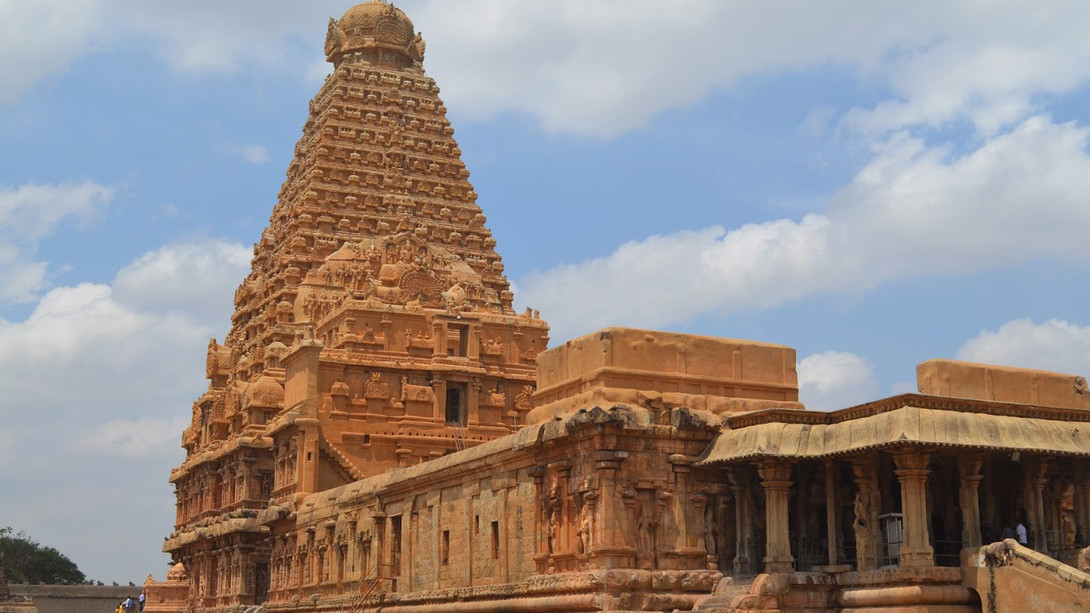
Thanjavur formerly known as Tanjore, is a famous temple city in the Indian state of Tamil Nadu. It is an important place of South Indian culture, art and architecture. It is one of the most important and most visited ancient sites in India today. Thanjavur is also noted for its bronze statue castings, handicrafts (especially the dancing doll) and South Indian musical instruments. It is also known as “The Art Capital of South India”
Thanjavur is famous for its agriculture too. When we visit Thanjavur (especially through railways), the beautiful green agricultural lands will be a delightful feast to our eyes. It is also stated as the rice granary of Tamil Nadu.
Most of the Great Chola Temples, which are UNESCO World Heritage sites, are located in and around Thanjavur town. The most prominent among these, is the Brihadeeswara Temple which is in the centre of the city. It is also home to many paintings, which is painted in a particular style, unique to the region.
Many old temples, fort and palaces have been a silent witness to Thanjavur’s historical importance.
Thanjavur is said to be named after a demon Thanjan-asura. Some says that, the last wish of the demon was that the place should be named after him, which was granted by the god. Cheras, Cholas and Pandyas were to be important kings ruling South India. The former of these were a great patron of art and literature.
The Brihadeeswara Temple
Also known as the Rajarajeshwara Temple was constructed by Chola king Raja Raja Cholan and his sister Kundavai. The construction of this temple was completed in 1010 which means that it is more than 1000 years old. This temple is devoted to Hindu god, Lord Shiva. It was constructed by the King to show his power and strength. It is the tallest temple building in India and is also known as Thanjavur Big Temple. The temple is surrounded by gardens and the entrance is free of cost. An excursion to Thanjavur cannot be complete without visiting this wonderful temple!
Its original deity was Rajarajeshwar, it was the Marathas who gave the name Brihadeeswara. This temple is entirely built of granite and it is said that more than 1,30,000 tons of granites have been used built it. A mystery associated with this temple is that the shadow of the main temple does not fall on ground. However, this was proved wrong by the scientists. ItsKumbam (a structure on the top) weighs nearly 80 tons. The statue of the Nandi (sacred bull) in the entrance of the temple is made out of a single stone.
According to the engravings present in the temple, Kunjara Mallan Raja Raja Perumthachan was the architect of this temple. It also has many other inscriptions which mention the different kinds of jewels used in the Chola period. 23 different varieties of pearls, 11 types of diamonds and rubies are mentioned in these inscriptions. The temple also has many musical pillars that make different sounds when tapped.
Manora Fort
The fort was built by The Maratha ruler Serfoji II in 1814. It is an eight-storeyed, hexagonal shaped tower, which is 23 m high looking over the majestic Bay of Bengal. The fort derives its name Manora, from the term Minaret.
In December 2004, many monuments including this fort were damaged by the Indian Ocean Tsunami. In 2007, The State Tourism Department decided to repair the structure and improve it, by building several additional facilities like tourist’s house. It one of the oldest forts of India, purely built on the Dravidian architectural style, and does not take any element from other architectural styles like Islamic, French or the British. So this fort became a great object of study for people studying architecture, as well.
This fort is also an excellent place to understand the history of Thanjavur. It gives great glimpses of the historical past of the Thanjavur. Traders from Sri Lanka used to come here and carry out trades with the people. It is said that, Serfoji II built an underground tunnel which connects the fort right to the heart of the Thanjavur temple.
Over the years, this fort has grown from being just a historical spot to a wonderful tourist spot which attracts numerous visitors from India as well as the countries worldwide.
Thanjavur Royal Palace
The Thanjavur Royal Palace is also called as The Thanjavur Maratha Palace Complex, is a beautiful heritage site that lies to the north of Brihadeeswara Temple. It was built by Vijaya Raghava Nayak.
At present, this palace consists of a Royal Palace Museum and the Sadar Mahal, along with the Queen’s courtyard, a Durbar Hall, and the Raja Serfoji II Memorial Hall. The durbar hall is said to have been built by the Marathas and has the throne canopy decorated with mirrors and precious gems. There is also located the Saraswathi Mahal Library which is one of the oldest historical libraries in India as well as Asia, which has rare collection of Palm leaf manuscripts and paper written in Tamil, Hindi, Telugu, Marathi and a few other languages native to India. The collection consists over 60,000 volumes. It is situated outside the palace and is one of the few medieval Manuscript libraries in the world.
There is also a museum inside Saraswathi Mahal which displays only selected books. The statue of the Goddess Saraswathi, big painting of Rama Pattabhishekam, many more beautiful Thanjavur paintings of the other Hindu deities such as Ganesha and Lakshmi, miniature paintings of various Maratha Kings, two big portrait paintings of Raja Serfoji II are all present in the museum.
Gangaikonda Cholapuram
The architectural greatness of Thanjavur does not end here, the Gangaikonda temple is another wonderful specimen of the beautiful temple carvings. This temple has been declared as one of UNESCO’s world heritage sites. The temple is more than thousand years old and is known as a fundamental part of Tamil history.
Conclusion
Thanjavur is not only considered as the rice bowl of Tamil Nadu but also as a traditional headquarters. Though this district is dominated by agriculture, the town is diverse in its own culture. This place has many more architectural marvels built during Chola reign.
By B. Shivani, Chennai


